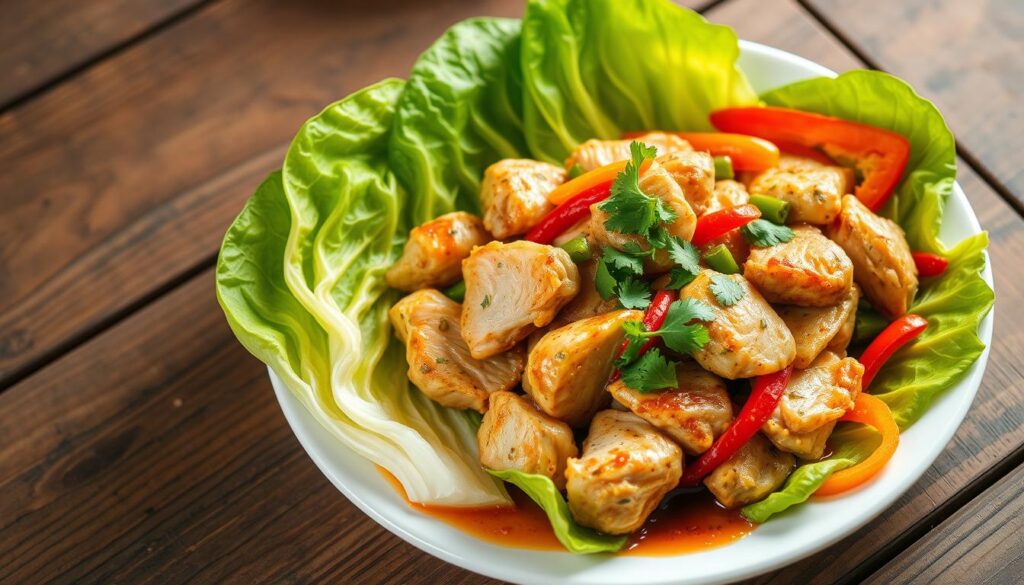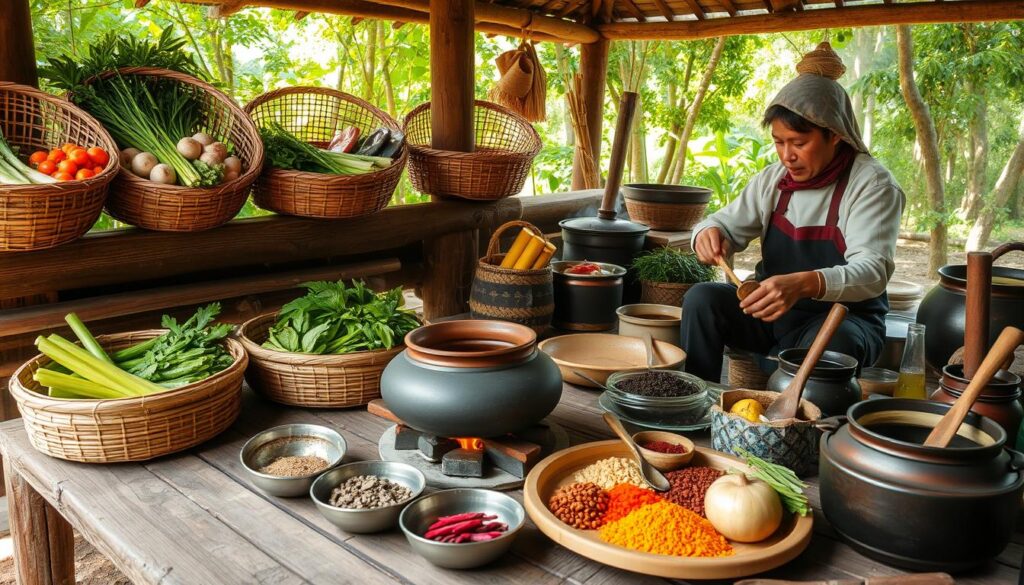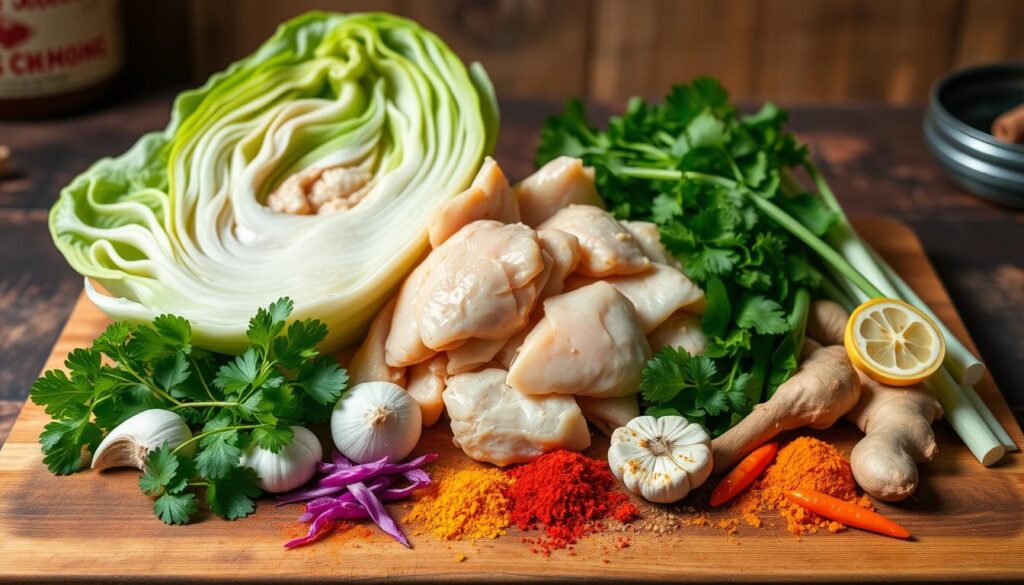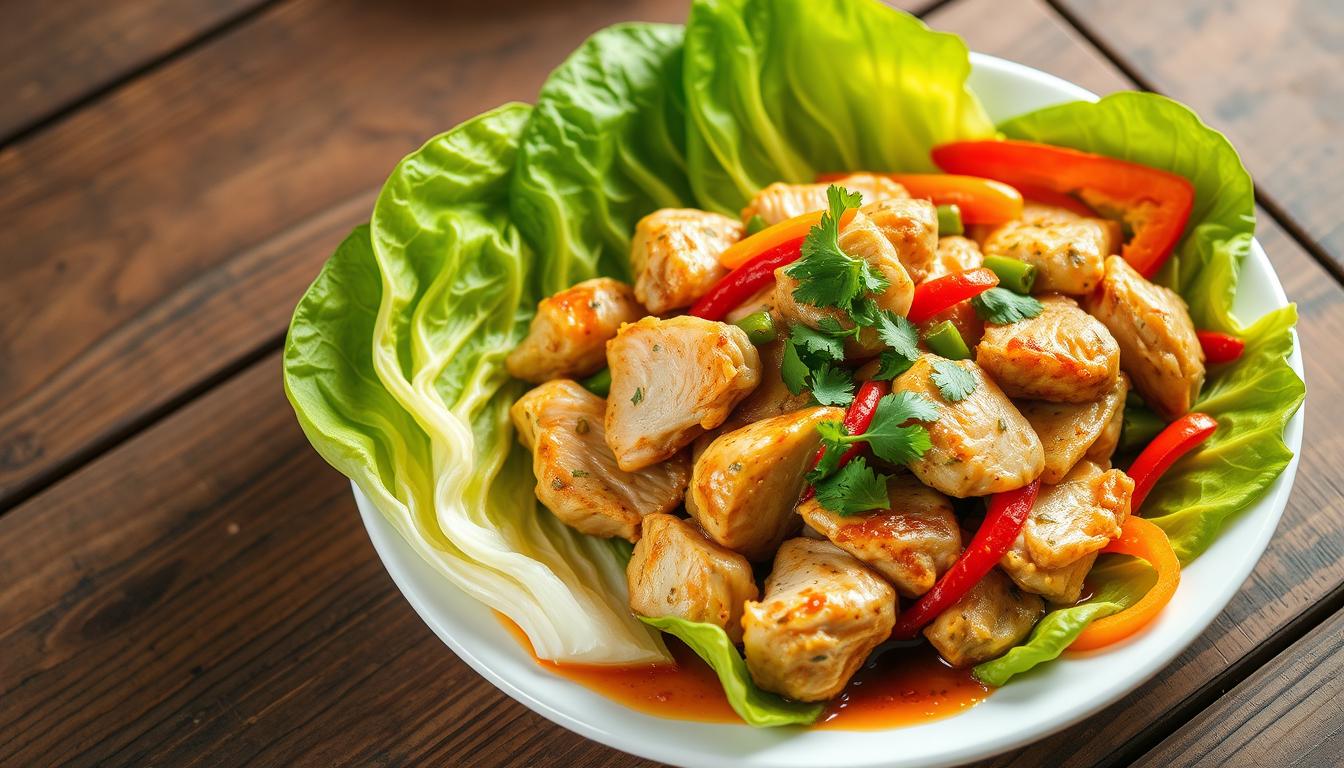
Growing up in a diverse culinary household, I learned that food is more than just food. It’s a bridge that connects generations and cultures. The Hmong cabbage and chicken recipe is a perfect example of this, blending Asian cooking traditions in a delicious way.
This recipe turns simple ingredients into a meal that tells a story of resilience, family, and culinary artistry. Every bite brings you closer to the kitchens of Hmong families. They have perfected this recipe over generations.
Whether you’re an experienced home cook or just starting out, this recipe offers a unique culinary adventure. It’s a journey that feeds both your body and soul.
- Understanding the Rich Heritage of Hmong Cuisine
- Essential Ingredients for Hmong Cabbage and Chicken Recipe
- Kitchen Tools and Equipment You’ll Need
- Selecting and Preparing the Perfect Cabbage
- Chicken Selection and Preparation Tips
- Step-by-Step Cooking Instructions
- Seasoning Secrets and Flavor Enhancement
- Serving Suggestions and Presentation
- Health Benefits and Nutritional Value
- Storage and Leftover Management
- Conclusion
Understanding the Rich Heritage of Hmong Cuisine
Hmong cuisine is a vibrant tradition that tells stories of survival and culture. It’s a world of flavors, techniques, and family bonds that goes beyond cooking.

Traditional Hmong recipes come from generations of resilience. They show how a community turns simple ingredients into amazing meals. These recipes are more than food; they’re a way to keep history and identity alive.
Origins and Cultural Significance
Hmong cuisine started in Southeast Asia’s mountainous areas. Each dish is a story of survival and community strength. The cooking methods highlight sustainable farming, seasonal ingredients, and clever food preservation.
- Sustainable farming practices
- Seasonal ingredient availability
- Resourceful food preservation techniques
Traditional Cooking Methods
Traditional Hmong cooking is all about simplicity and flavor. Techniques like slow-cooking and open-fire cooking let ingredients shine. Communal cooking is key, where meals are made and shared together.
The Role of Family Recipes
“In our kitchen, recipes are living memories passed from grandparent to parent to child.” – Traditional Hmong saying
Family recipes in Hmong cuisine are like historical documents. They keep cultural knowledge alive through generations. Each recipe holds emotional value, connecting family members and preserving ancestral wisdom.
Essential Ingredients for Hmong Cabbage and Chicken Recipe
To make a true hmong cabbage and chicken recipe, you need the right ingredients. These ingredients bring the true taste of southeast asia to your dish. A mix of fresh veggies, proteins, and spices makes a simple meal into a work of art.

Start by picking the best ingredients for your recipe. Napa cabbage is the top choice. It has soft leaves and a mild taste that soaks up flavors well.
- Fresh Napa cabbage (primary vegetable)
- Bone-in chicken thighs or drumsticks
- Garlic and ginger
- Green onions
- Fish sauce
- Chili peppers
Choosing the right protein is key. Bone-in chicken pieces taste better and are softer than boneless ones.
| Ingredient Category | Recommended Options | Flavor Profile |
|---|---|---|
| Cabbage | Napa Cabbage | Mild, slightly sweet |
| Protein | Chicken Thighs | Rich, tender |
| Aromatics | Garlic, Ginger | Intense, warming |
Remember, fresh ingredients are crucial for southeast asian flavors. Local farmers markets offer top-notch produce that will improve your dish.
The secret to an authentic hmong dish lies not just in the ingredients, but in the love and tradition poured into its preparation.
Don’t be afraid to adjust your ingredients. While traditional recipes have specific needs, home cooking lets you tailor your dish to your liking and what you have on hand.
Kitchen Tools and Equipment You’ll Need
To make a real Hmong chicken and cabbage dish, you need the right tools. Whether you’re experienced or new, the right equipment makes a big difference.

Your kitchen will mix old Hmong ways with new ease. Here are the key tools for a tasty chicken and cabbage dish.
Traditional Cooking Tools
Old Hmong kitchens used simple, effective tools. These tools show the rich culture of Asian cooking.
- Clay pot for slow cooking
- Bamboo steamer
- Hand-carved wooden cutting board
- Stone mortar and pestle
Modern Preparation Equipment
Today’s gadgets make cooking chicken and cabbage easier and fun.
| Tool | Purpose |
|---|---|
| Food processor | Quick vegetable chopping |
| Digital kitchen scale | Precise ingredient measurements |
| Instant-read thermometer | Checking chicken doneness |
Essential Cooking Vessels and Utensils
The right pots and pans can make your dish better. They help with flavor and technique.
- Cast-iron wok
- Non-stick skillet
- Sharp chef’s knife
- Wooden cooking spoons
- Stainless steel mixing bowls
“The right tools transform cooking from a task to an art.” – Hmong Culinary Wisdom
Pro tip: Invest in quality tools that will last and enhance your cooking experience.
Selecting and Preparing the Perfect Cabbage
Choosing the right cabbage is key to making great chicken and cabbage recipes. Not all cabbages are the same. Knowing their differences can make your Hmong-inspired dish even better.
There are many cabbage types, each with its own taste and texture. Here are some great choices for your stir fry:
- Green Cabbage: Most common, crisp texture, mild flavor
- Napa Cabbage: Softer leaves, slightly sweet taste, ideal for authentic Hmong cooking
- Savoy Cabbage: Delicate, crinkled leaves with a tender bite
To prepare cabbage, start by removing the outer leaves and washing it well. Cut the cabbage into even pieces for even cooking. For a great stir fry, cut it into small chunks that cook fast and stay crisp.
“The secret to an amazing cabbage stir fry is in the preparation” – Hmong Culinary Tradition
Here are some tips to keep your cabbage fresh:
- Use a sharp knife for clean cuts
- Pat cabbage dry before cooking
- Cut just before cooking to preserve nutrients
- Avoid overcrowding the pan during stir frying
By picking the right cabbage and preparing it well, you’ll make a dish that celebrates Hmong culinary traditions.
Chicken Selection and Preparation Tips
Getting the perfect chicken for your Hmong-inspired dish is key. You need to pick the right meat for the best flavor and tenderness.
Selecting the Ideal Chicken Cuts
For a true fried chicken with cabbage taste, choose the right cuts:
- Boneless chicken thighs for rich, tender meat
- Chicken breasts for a leaner option
- Bone-in cuts for deeper flavor profiles
Marination Magic
Marinating makes your chicken stir fry amazing. Here’s how to do it right:
- Start with fresh garlic and ginger in your marinade
- Let it sit for 30-60 minutes to soak up flavors
- Add light soy sauce for that Hmong taste
Food Safety Essentials
“Clean hands, safe food, delicious meals.” – Hmong Culinary Wisdom
Safe chicken handling is crucial. Always wash your hands and use separate boards. Cook chicken to 165°F for safe and tasty fried chicken with cabbage.
| Preparation Step | Safety Tip |
|---|---|
| Cutting | Use clean, sanitized knife and board |
| Marinating | Refrigerate during process |
| Cooking | Check internal temperature |
Step-by-Step Cooking Instructions
Making a traditional hmong cabbage and chicken recipe needs attention to detail. This method turns simple items into a tasty dish full of traditional flavors.
Your cooking journey starts with getting your ingredients ready. Here are the key steps:
- Prepare your ingredients and workspace
- Clean and chop the cabbage into uniform pieces
- Cut chicken into bite-sized portions
- Season the chicken with traditional spices
- Heat your cooking vessel
Keeping the right cooking temperature is key in asian cooking. You should use medium-high heat. This helps keep the chicken moist and gives it a golden color.
“Cooking is an art that connects generations and preserves cultural traditions” – Hmong Culinary Master
Here’s a detailed breakdown of the cooking sequence:
| Step | Action | Time/Temperature |
|---|---|---|
| 1 | Sear chicken | 4-5 minutes, 375°F |
| 2 | Add cabbage | 3-4 minutes |
| 3 | Season and stir | 2 minutes |
Pro tip: Use a wok or heavy-bottomed skillet for best results in your hmong cabbage and chicken recipe.
Look for the cabbage to turn slightly soft and tender. This means your dish is almost done. The goal is to cook the chicken well and keep the cabbage crisp.
Seasoning Secrets and Flavor Enhancement
Unlocking the magic of southeast asian flavors is more than just following a recipe. The art of seasoning turns a simple dish into a culinary masterpiece. This is especially true when preparing traditional Hmong cuisine.
Traditional Hmong Spices That Elevate Your Dish
Hmong cooking celebrates bold and vibrant tastes. It uses a carefully curated selection of spices. Your traditional recipes will come alive with these essential ingredients:
- Fresh lemongrass
- Ginger root
- Garlic
- Thai chili peppers
- Cilantro
Balancing Flavor Profiles
Creating the perfect balance is key. The key is to blend heat, sweetness, and umami in harmonious proportions. Start with small amounts and taste as you go.
“Cooking is about passion, and the right seasoning can transport you across continents.” – Anonymous Hmong Chef
Regional Flavor Variations
Different Hmong communities across Southeast Asia have unique twists. Some regions prefer spicier profiles, while others emphasize herbal notes. Your culinary journey will reveal the beautiful diversity of these flavors.
Experimenting with these seasoning techniques will help you master the art of Hmong cuisine. You’ll create memorable meals that honor its rich cultural heritage.
Serving Suggestions and Presentation
Presenting a Hmong cabbage and chicken dish is an art. It’s not just about cooking. In traditional family recipes, how you present it is as important as the taste. Your meal becomes a celebration of Hmong culinary heritage with the right serving techniques.
When serving your delicious creation, consider these key presentation tips:
- Use a wide, shallow ceramic plate to showcase the dish’s vibrant colors
- Garnish with fresh cilantro and thinly sliced green onions
- Arrange the chicken and cabbage in an overlapping pattern
- Sprinkle toasted sesame seeds for added texture
Traditional hmong cuisine emphasizes family-style dining. Serve your dish with steamed jasmine rice or thin rice noodles. Pro tip: Provide small side dishes of chili sauce or pickled vegetables to enhance the main course’s flavor profile.
“In Hmong culture, a meal is more than food—it’s a moment of connection.” – Traditional Hmong Chef
Your plating should invite conversation and create a warm, inviting atmosphere. It should reflect the heart of family recipes passed down through generations.
Health Benefits and Nutritional Value
Your hmong cabbage and chicken recipe is not just tasty. It’s also packed with nutrients that boost your health. This traditional dish from Laos has the right mix of proteins, vitamins, and minerals for a healthy diet.
Chicken is a great source of lean protein. It helps build and repair muscles. A single serving has about 25-30 grams of protein, perfect for those who work out or care about their health.
Nutritional Breakdown
| Ingredient | Key Nutrients | Health Benefits |
|---|---|---|
| Cabbage | Vitamin C, K, Fiber | Boosts immunity, supports digestion |
| Chicken | Protein, Vitamin B6 | Muscle growth, metabolism support |
| Herbs | Antioxidants | Reduces inflammation |
The hmong cabbage and chicken recipe is a nutritional powerhouse. It uses fresh ingredients and traditional cooking. This way, you get a meal that’s good for your body and soul.
“Food is our medicine, and medicine is our food” – Traditional Hmong Wisdom
- Low in calories
- High in protein
- Rich in micronutrients
- Supports weight management
If you’re looking for a healthy meal or want to try something new, this recipe is great. It offers amazing health benefits, making it more than just a tasty dish.
Storage and Leftover Management
Keeping your family recipes fresh is key. Proper storage helps your Hmong chicken and cabbage dish stay tasty for more meals.
Refrigeration Techniques
Here are important tips for storing your dish:
- Cool the dish completely before refrigerating
- Use airtight containers to maintain freshness
- Store within two hours of cooking
- Refrigerate for up to 3-4 days maximum
Freezing Your Family Recipes
Freezing extends the life of your favorite Hmong dishes. Proper freezing maintains both flavor and nutritional value.
- Divide into portion-sized containers
- Remove excess air to prevent freezer burn
- Label with date and contents
- Freeze for up to 2-3 months
Safe Reheating Practices
“The key to great leftovers is maintaining the original dish’s quality and safety” – Hmong Culinary Experts
Reheat your chicken and cabbage recipes well. Make sure the internal temperature hits 165°F (74°C) to kill bacteria. Use a food thermometer for the best results.
Food Safety Tips
Follow these food safety tips to keep your family healthy:
- Never leave food at room temperature for more than 2 hours
- Discard any dish with unusual odor or appearance
- Avoid repeated reheating of the same portion
- Always use clean utensils when handling stored food
Conclusion
Your journey through this Hmong cabbage and chicken recipe is more than cooking. It’s a dive into cultural culinary traditions that connect us across generations. By making this dish, you’re part of a long history of Hmong cooking.
This recipe is more than just food. It’s a lively showcase of Hmong cuisine, turning simple ingredients into unforgettable meals. Every step you take brings you closer to the cultural stories in each bite.
Cooking is a personal art. While honoring the recipe’s roots, feel free to add your own twist. Your kitchen becomes a place of creativity, where family recipes come alive. Share your stories with loved ones, spreading the joy of Hmong cooking.
Exploring Hmong culinary traditions opens a world of flavors. These flavors tell stories of strength, community, and creativity. Your passion for learning and sharing these recipes will keep this cuisine alive for generations to come.
FAQ
What makes Hmong cabbage and chicken recipe unique?
The Hmong cabbage and chicken recipe is special. It mixes traditional Southeast Asian flavors with fresh cabbage, tender chicken, and spices. This dish is a perfect blend of nutrition, taste, and cultural tradition.
How difficult is this recipe for home cooks?
This recipe is easy for anyone to make. It has simple steps and basic cooking techniques. Even if you’re new to Southeast Asian cooking, you can make a delicious Hmong dish.
Can I substitute ingredients if I can’t find traditional Hmong ingredients?
Yes, you can! If you can’t find traditional ingredients, you can use substitutes. For example, you can try different cabbage types or change the seasonings. This way, you can still enjoy the dish’s main flavors.
Is this recipe suitable for special diets?
This recipe is very flexible. You can make it gluten-free by using the right seasonings. To cut calories, use skinless chicken and less oil. Vegetarians can even make a tofu version.
What are the best side dishes to serve with this recipe?
Serve it with steamed jasmine rice, sticky rice, or rice noodles. Fresh herbs like cilantro or mint are also great. A cucumber salad or pickled vegetables add a nice contrast.
How long can I store leftovers of this dish?
Leftovers can be stored in an airtight container in the fridge for 3-4 days. Reheat it gently to keep the chicken and cabbage tender. You can also freeze it for up to 2-3 weeks.
What type of cabbage works best for this recipe?
Napa cabbage is best, but green cabbage or bok choy work too. Choose a fresh, crisp cabbage that can hold up to stir-frying and absorb flavors well.
Are there regional variations of this recipe?
Yes! Hmong communities have their own versions. Some use more spices, while others add local herbs or change cooking methods. These variations show the diversity of Hmong cuisine.


1 thought on “Hmong Cabbage and Chicken Recipe: The Perfect Fusion of Flavor and Nutrition”